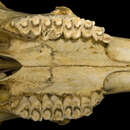ar
الأسماء في صفحات التنقل


The number of predators greatly affects the population of waterbuck. The main predators - lions, hyaenas, and leopards - usually attack newborn calves (Kingdon, 1982).
Perception Channels: tactile ; chemical
---
US Federal List: no special status
CITES: no special status
IUCN Red List of Threatened Species: least concern
Waterbuck are hunted for sport in Africa and are found in zoos throughout the world (Kingdon, 1982).
Positive Impacts: food ; body parts are source of valuable material
Waterbuck are very water dependent. They eat a variety of grasses, both medium and short in length. Their diet is very rich in protein. When the amount of available grass is low, waterbuck eat other herbs to satisfy their needs (Estes, 1991).
There are two main groups of waterbuck. The ellipsiprymnus group is found throughout southeast Africa. The defassa group is found in northeastern, central, and western Africa (Kingdon, 1982).
Biogeographic Regions: ethiopian (Native )
Waterbuck prefer grassland habitat that is close to water. The best habitats are by draining lines and in valleys. While they prefer dry ground, they remain close to water for food and as an escape from predators (Estes, 1991).
Terrestrial Biomes: savanna or grassland
Average lifespan
Status: captivity: 18.0 years.
Average lifespan
Status: captivity: 18.7 years.
Average lifespan
Sex: female
Status: wild: 18.5 years.
Waterbuck have long bodies and necks and short legs. The hair is coarse, and they have a mane on their necks (Estes, 1991). Their head and body length ranges from 177 - 235 cm and shoulder height from 120 - 136 cm. Only male waterbuck have horns, which are curved forward and vary in length from 55 - 99 cm. The length of the horns is determined by the age of the waterbuck (Kingdon, 1982). Body color ranges from gray to red-brown and darkens with age. The lower part of the legs is black with white rings above the hooves (Estes, 1991).
Range mass: 160 to 300 kg.
Other Physical Features: endothermic ; bilateral symmetry
Average basal metabolic rate: 148.949 W.
Male waterbuck mature at six years of age, and females reach maturity in three years. Breeding near the equator is perennial. The generations in these populations are spaced about ten months apart. In northern Africa, the waterbuck calve annually. The gestation period is about eight to eight and a half months. A few days before calving, mothers isolate themselves in thickets. After birth, it takes newborns about half an hour to gain their feet. The young calves remain hidden for two to four weeks (Estes, 1991).
Range number of offspring: 1 to 2.
Average number of offspring: 1.
Range gestation period: 9.07 to 9.57 months.
Range weaning age: 6 to 7 months.
Key Reproductive Features: gonochoric/gonochoristic/dioecious (sexes separate); sexual
Average birth mass: 9000 g.
Average number of offspring: 1.
Average age at sexual or reproductive maturity (female)
Sex: female: 771 days.
Parental Investment: altricial